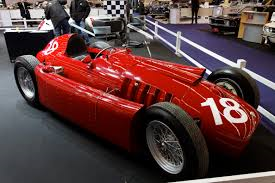1956 D50 A

The descriptions of the Classic Cars in the Directory were partly generated or supplemented with the help of artificial intelligence (AI). The content may occasionally not always be entirely accurate or factually correct despite careful checking.
The Lancia Ferrari D50 A 1956 is an iconic and legendary example of automotive engineering and design. Born from the collaboration between two of the most prestigious car manufacturers of the time, Lancia and Ferrari, this car has become a symbol of speed, power, and innovation that still captures the imagination of petrolheads worldwide.
The Lancia Ferrari D50 A 1956 is a single-seat open-wheel racing car that was built for the 1956 Formula One season. Its chassis and suspension were designed by Lancia, while the engine and transmission were designed and produced by Ferrari. The car's performance and handling were widely praised by racing drivers, and it won the Monaco Grand Prix in 1956.
Under the hood of the Lancia Ferrari D50 A 1956 lies a 2.5-liter V8 engine that produces 260 horsepower at 8,500 rpm. The engine features a 90-degree angle between the cylinder banks, dry sump lubrication, and twin ignition systems. The transmission is a five-speed manual gearbox that is mounted transversely behind the engine. The car's top speed is around 190 mph, and its acceleration capabilities are impressive, reaching 60 mph in less than five seconds.
The Lancia Ferrari D50 A 1956 chassis is made of lightweight, high-strength tubular steel that provides excellent rigidity and stiffness. The suspension system uses double wishbones at the front and a de Dion axle at the rear, with coil springs and dampers all around. The car's brakes are drum-type, and they provide excellent stopping power thanks to their large size and efficient cooling systems.
The aerodynamics of the Lancia Ferrari D50 A 1956 are also noteworthy. The open-wheel design, with its streamlined and sculpted bodywork, allows for optimal airflow around the car, reducing drag and increasing downforce. The car's front nose cones and rear spoiler also contribute to its aerodynamic efficiency, providing additional stability and grip at high speeds.
In addition to its technical and mechanical features, the Lancia Ferrari D50 A 1956 is also famous for its iconic design. The car's sleek and elegant lines, combined with its bold color scheme, make it a true work of art on wheels. The steering wheel is also unique, featuring a distinctive shape and a large central horn button that adds an extra touch of class.
In conclusion, the Lancia Ferrari D50 A 1956 is a masterpiece of automotive engineering, design, and innovation. Its technical features, including its high-performance engine, advanced suspension system, and efficient aerodynamics, make it one of the most advanced racing cars of its time. Its iconic design and style also make it a timeless classic that still inspires awe and admiration to this day.
Milestones
- 1954: Lancia starts developing the D50 race car with an innovative engine design - 1955: Alberto Ascari wins the Monaco Grand Prix in a D50, marking Lancia's first Formula One victory - 1955: Lancia withdraws from racing due to financial difficulties, and sells their D50 project to Scuderia Ferrari - 1956: Ferrari modifies the D50 to fit their own V8 engine and renames it the Lancia Ferrari D50 A - 1956: Juan Manuel Fangio wins the Argentine Grand Prix and Monaco Grand Prix in a D50 A - 1956: Eugenio Castellotti is killed in a testing accident while driving a D50 A at Modena - 1957: Peter Collins wins the International Trophy race at Silverstone in a D50 A - 1957: Mike Hawthorn wins the French Grand Prix in a D50 A, marking Ferrari's first Formula One victory under their own name - 1958: Enzo Ferrari sells the D50 A to the British Racing Partnership team - 1959: Stirling Moss wins the Monaco Grand Prix in a BRP-entered D50 A, marking the car's final Formula One victory.Technical
• The Lancia Ferrari D50 A was a Formula One race car manufactured by Lancia in collaboration with Ferrari in 1956. • The car had a front-engine configuration and was designed by Vittorio Jano. • It had a tubular steel frame, with a lightweight aluminum body. • The engine was a 2.5-liter V8, producing 260 horsepower at 8,000 rpm. • The car had a 5-speed manual transmission and used drum brakes. • The suspension was a double-wishbone design with coil springs and hydraulic dampers. • The car was driven by some of the most talented drivers of the time, including Juan Manuel Fangio and Eugenio Castellotti. • The D50 A finished in second place in the 1956 Formula One World Championship, behind the Maserati 250F driven by Fangio. • The car was later converted to a Ferrari badge and was driven by legendary drivers such as Mike Hawthorn and Peter Collins. • Only three examples of the Lancia Ferrari D50 A were built, making it a rare and valuable collector's item today.